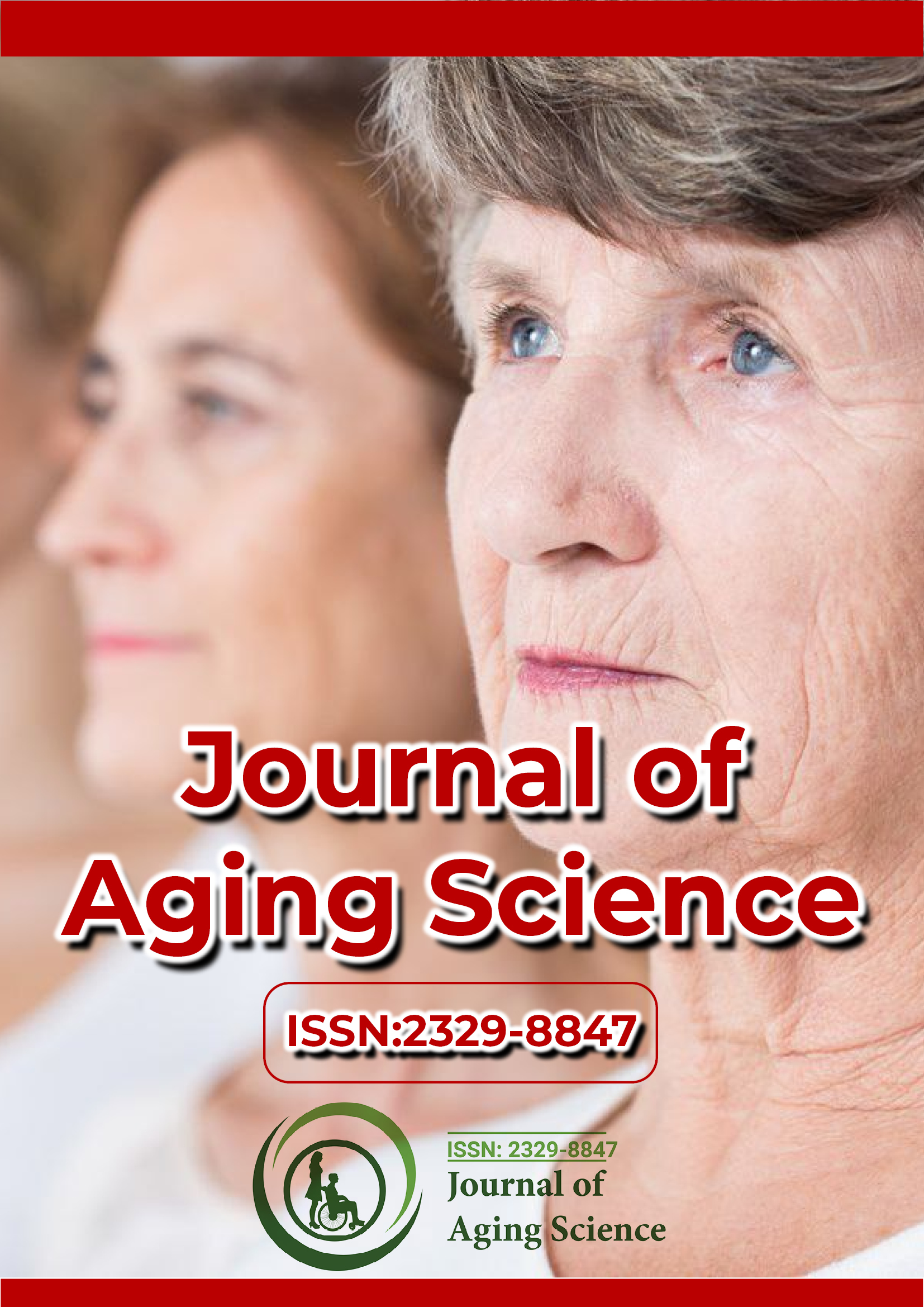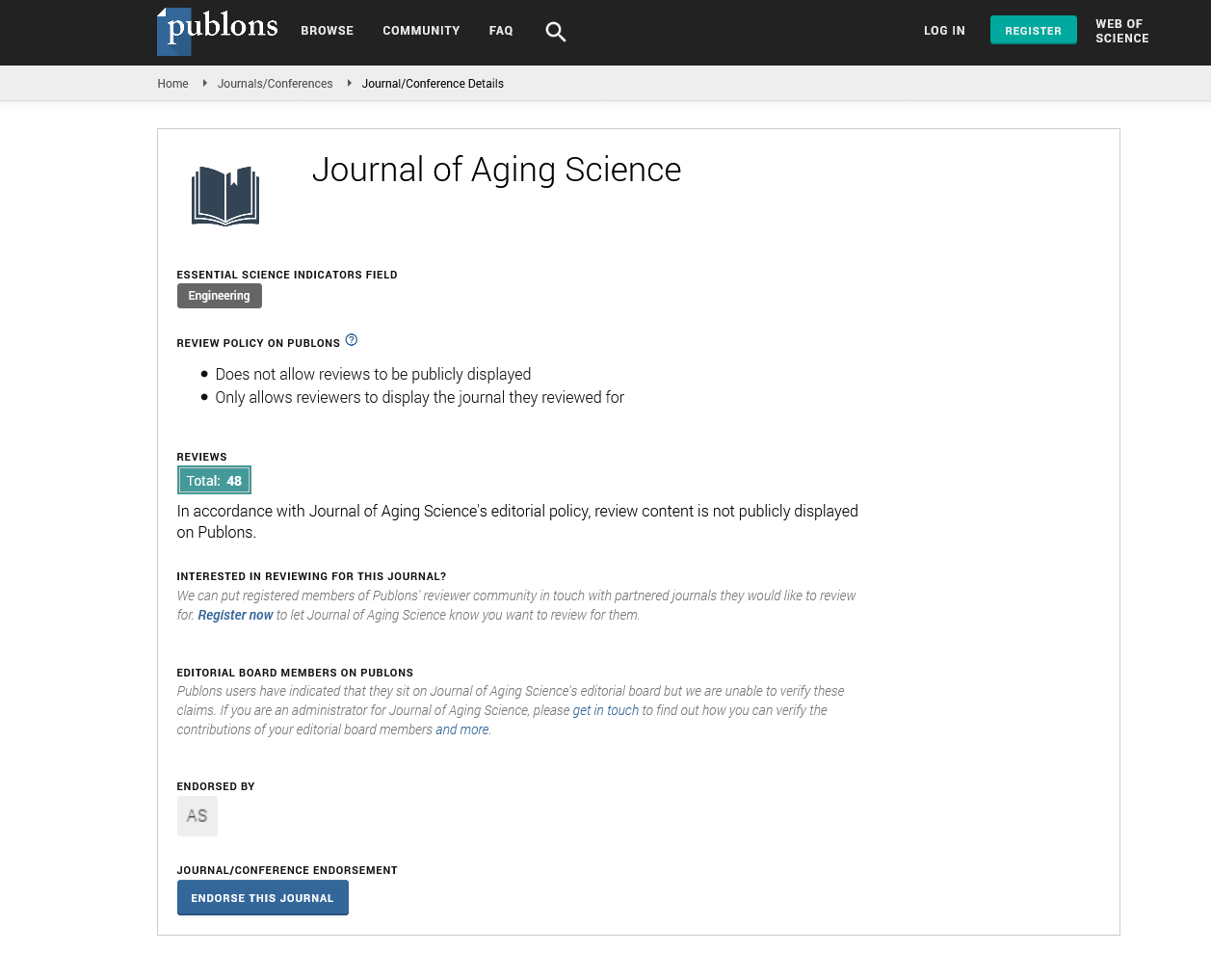Indexed In
- Open J Gate
- Academic Keys
- JournalTOCs
- ResearchBible
- RefSeek
- Hamdard University
- EBSCO A-Z
- OCLC- WorldCat
- Publons
- Geneva Foundation for Medical Education and Research
- Euro Pub
- Google Scholar
Useful Links
Share This Page
Journal Flyer

Open Access Journals
- Agri and Aquaculture
- Biochemistry
- Bioinformatics & Systems Biology
- Business & Management
- Chemistry
- Clinical Sciences
- Engineering
- Food & Nutrition
- General Science
- Genetics & Molecular Biology
- Immunology & Microbiology
- Medical Sciences
- Neuroscience & Psychology
- Nursing & Health Care
- Pharmaceutical Sciences
Commentary - (2025) Volume 13, Issue 2
The Impact of Aging on the Cardiovascular System and Strategies for Prevention
Sumio Araki*Received: 28-Mar-2025, Manuscript No. JASC-25-28626; Editor assigned: 31-Mar-2025, Pre QC No. JASC-25-28626 (PQ); Reviewed: 07-Apr-2025, QC No. JASC-25-28626; Revised: 14-Apr-2025, Manuscript No. JASC-25-28626 (R); Published: 28-Apr-2025, DOI: 10.35248/2329-8847.25.13.410
Description
Aging is an inevitable biological process that affects all organ systems, including the cardiovascular system. With increasing age, structural and functional changes occur in the heart and blood vessels, leading to a higher risk of Cardiovascular Diseases (CVDs) such as hypertension, atherosclerosis, heart failure and stroke. However, adopting preventive strategies such as lifestyle modifications, dietary interventions and medical management can help mitigate these risks and promote cardiovascular health in aging populations. This article explores the impact of aging on the cardiovascular system and presents effective strategies for prevention.
Structural and functional changes in the cardiovascular system with aging
The cardiovascular system undergoes significant changes as a person ages, affecting heart function, vascular integrity and overall circulation. Some of the key age-related changes include:
Arterial stiffening and reduced elasticity: One of the most significant age-related cardiovascular changes is arterial stiffening. The large arteries, such as the aorta, lose their elasticity due to:
• Increased collagen deposition and reduced elastin fibers.
• Chronic low-grade inflammation leading to vascular remodeling
. • Endothelial dysfunction resulting in impaired vasodilation.
• These changes contribute to higher systolic blood pressure, increased cardiac workload and a greater risk of hypertension and heart failure.
Left ventricular hypertrophy and cardiac remodeling: Aging leads to Left Ventricular Hypertrophy (LVH) and structural remodeling of the heart, which results from:
• Increased myocardial fibrosis and stiffening of the ventricular walls.
• Prolonged exposure to elevated blood pressure and workload.
• Decline in cardiac myocyte function and increased apoptosis.
• These alterations reduce the heart's efficiency in pumping blood, increasing the risk of heart failure and arrhythmias.
Reduced maximum heart rate and cardiac output: As individuals age, their maximal heart rate (HRmax) decreases, leading to:
• Reduced cardiac output during physical exertion.
• Decreased responsiveness of beta-adrenergic receptors, limiting heart rate variability.
• Increased dependence on stroke volume to maintain adequate cardiac function.
• These changes contribute to decreased exercise tolerance and an increased risk of cardiovascular complications.
Impaired endothelial function and atherosclerosis: The endothelium, which lines blood vessels, plays a critical role in vascular health. With aging, endothelial dysfunction occurs due to:
• Reduced Nitric Oxide (NO) production, leading to impaired vasodilation.
• Increased oxidative stress and inflammation.
• Accumulation of lipids and plaque formation, contributing to atherosclerosis.
• Endothelial dysfunction is a major contributor to Coronary Artery Disease (CAD) and stroke in aging populations.
Increased risk of cardiovascular diseases in aging: Due to these physiological changes, the aging population is at a higher risk of developing cardiovascular diseases, including:
• Elevated blood pressure due to arterial stiffness and vascular resistance.
• Narrowing of coronary arteries due to plaque buildup, increasing the risk of heart attacks.
• Weakened heart muscle leading to reduced pumping ability and fluid retention.
• Irregular heart rhythm due to electrical and structural changes in the atria.
• Increased likelihood of blood clots and impaired cerebral circulation.
Strategies for preventing age-related cardiovascular decline
While aging-related cardiovascular changes are inevitable, preventive measures can significantly reduce the risk of cardiovascular diseases and improve heart health. The following strategies can help maintain cardiovascular function and longevity:
Regular physical activity: Exercise is one of the most effective strategies for maintaining cardiovascular health. Benefits include:
• Improved vascular elasticity and endothelial function.
• Reduction in blood pressure and heart rate.
• Increased cardiac efficiency and stroke volume.
• Enhanced lipid metabolism and reduced risk of atherosclerosis.
The American Heart Association (AHA) recommends at least 150 minutes of moderate-intensity aerobic exercise per week or 75 minutes of vigorous-intensity exercise, along with resistance training.
Heart-healthy diet
A balanced diet plays an important role in cardiovascular disease prevention.
Key dietary components include: Mediterranean diet: Rich in fruits, vegetables, whole grains, healthy fats (e.g., olive oil) and lean proteins.
Omega-3 fatty acids: Found in fatty fish, flaxseeds and walnuts, which help reduce inflammation and improve lipid profiles.
Limiting processed foods: Reducing fats, refined sugars and excess sodium to prevent hypertension and obesity.
Blood pressure and cholesterol management:
• Regular monitoring of blood pressure and lipid levels is necessary in aging individuals.
• Lifestyle modifications and medications such as statins (for cholesterol) and antihypertensives can help maintain optimal levels..
• Managing stress through mindfulness and relaxation techniques can also aid in blood pressure control.
Maintaining a healthy weight and avoiding obesity
Obesity increases the risk of hypertension, diabetes and cardiovascular disease. Effective weight management strategies include:
• A combination of diet, physical activity and behavioral modifications.
• Reducing calorie intake while ensuring adequate nutrient consumption.
• Monitoring waist circumference, as central obesity is particularly harmful to cardiovascular health.
Smoking cessation and alcohol moderation
Smoking: Tobacco use accelerates arterial stiffening and increases the risk of heart disease and stroke. Quitting smoking significantly improves cardiovascular health.
Alcohol: Excessive alcohol consumption can lead to high blood pressure and heart disease. Limiting intake to moderate levels (one drink per day for women, two for men) is recommended.
Regular health screenings and medical checkups
Preventive healthcare is important in detecting early signs of cardiovascular disease. Routine screenings should include: • Blood pressure checks (at least annually).
• Lipid profile assessments (cholesterol and triglycerides).
• Blood glucose monitoring to prevent diabetes-related cardiovascular risks.
• Electrocardiograms (ECG) and echocardiograms if symptoms of heart disease are present.
Conclusion
Aging brings inevitable changes to the cardiovascular system, increasing the risk of heart disease, hypertension and stroke. However, these risks can be mitigated through proactive lifestyle choices, including regular exercise, a heart-healthy diet, weight management, smoking cessation and stress reduction. Regular medical checkups and early intervention further enhance cardiovascular health and longevity. By implementing these strategies, aging individuals can maintain optimal heart function, reduce disease risk and improve their overall quality of life.
Citation: Araki S (2025). The Impact of Aging on the Cardiovascular System and Strategies for Prevention. J Aging Sci. 13:409.
Copyright: © 2025 Araki S. This is an open-access article distributed under the terms of the Creative Commons Attribution License, which permits unrestricted use, distribution and reproduction in any medium, provided the original author and source are credited.

